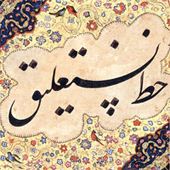
1301: Around this year or a few decades after that completed the Demotte Shahnameh. Among the greatest illustrated copies of the Shahnameh to be commissioned by the Ilkhanid rulers is the Demotte Shahnameh, named after the dealer who originally divided it. The page illustrated here shows Bahram Gur sending Narsi as viceroy to Khurasan; it was painted at Tabriz during the 1330s, or slightly later. This illustrated book was written by Naskh.

1310: The inscription of Ala’i Darwaza was written in an extension of the Quwwat ul Islam Masjid in Delhi. The Delhi Imperial style of the Naskh which is characterised by boldness, vigour and elegance reached its climax in the calligraphy of the Al’i Darwaza inscriptions.

1313: The first series of inscriptions on the dome of Mausoleum of Oljeitu in Sultaniyeh Northwest of Iran were written. There are a number of Kufic, Thuluth and Naskh inscriptions in different styles. This vast mausoleum, the only significant part of the Ilkhanid capital at Sultaniyeh to have survived, was built for Oljeitu. The blue-tiled dome, more than 50m high, sits on an octagonal chamber with eight huge vaulted niches on the interior, and can be seen from a great distance across the surrounding plains.

1314: The historical book of Jami' al-Tawarikh was written by the great Persian vizier of Ilkhanid Rashid aI-Din Fadl allah Hamadani. Anxious to legitimize their rule in Western Iran, the Ilkhanids were responsible for the patronage of a large body of historical writing, including the Rashid aI-Din's Jami' al-Tawarikh ('Compendium of Chronicles'). The illustration shown here depicts Shakyamuni offering fruit to the Devil.

1321: The Tughlaq Dynasty (1321-1414) was started in Delhi by Ghiyath al-Din Tughluq (r. 1321-1325).

1325: Muhammad bin Tughluq (born c.1300, d. 1351) also known as, Jauna Khan (r. 1325-1351 C.E./725-752 A.H.) second sultan of the Tughluq dynasty come to power. He briefly extended the rule of the Delhi Sultanate of Northern India over most of the subcontinent. He was personally an expert in calligraphy.

1325: Hazrat Nizamuddin Auliya (1238 -1325) the famous Sufi saint of the Chishti Order died in the Indian Subcontinent.

1336: Vijayanagar dynasty (1336–1565) was founded as the Kingdom of Bisnaga by the Portuguese in the Deccan Plateau.

1340: Muzaffarid dynasty (ca. 1340–1393) came to power in Southwest of Iran following the breakup of the Ilkhanate in the 14th century.

1347: Bahmanid sultanate (1347–1528) the first independent Islamic Kingdom in South India northern Deccan started.

Early-mid 14th century: Some superb Qur'ans were produced under the Ilklianids, in particular Oljeitu, and also for the great vizier Rashid al-Din. These have brilliantly illuminated frontispieces and art typically written in either the Muhaqqaq or Rayhan script. One Ilkhanid Qur’an found its way to Mamiuk Cairo when it was to influence Qur’an production there.

1354: The Mihrab of Madrasa Imami, a religious school founded in Isfahan in Iran. It is made of glazed earthenware cut into small pieces and embedded in plaster with masterpieces of calligraphic inscription.

1360: Jalayirid rule (ca. 1360–1406) came to power in northwest of Iran.

1370 April (771 AH), The Timurids, was founded by the legendary conqueror Timur (Tamerlane). The campaigns of Timur were devastating and far-reaching: Baghdad was taken in 1393, Delhi in 1398, and the Ottoman Sultan Bayazid I was defeated near Ankara in 1402. Artists and craftsmen were taken from the cities Timur conquered to embellish his capital, Samarqand. His vast empire collapsed after his death, but Herat emerged as a brilliant cultural centre during the 15th century under his son Shah Rukh. Timurids were great patrons of art and calligraphy.

1375: A Kufic inscription forming the upper panel of a piece of Tughra writing cut in the stone over the prayer niche in the transept of the Adinah Masjid at Panduah, Bengal.

1390: Hafez died when he was 70 years old. He is the greatest lyric poet of the Persian language and wrote his most famous work, The Divan. Hafez was a Sufi and his poetry is characterized by the sense of beauty, love of humanity and devotion to God.

1395: Mir Ali Tabrizi wrote Divan Of khajo-e kermani in Nasta’liq for Sultan Ahmad Jalayer (1381-1400) in Baghdad. The invention of Nasta'liq calligraphy style is attributed to him.

1398: Timur's forces crossed the Hindu Kush and descended upon northern India, sacking Delhi. Timur began a trek starting to invade the reigning Sultan Nasir-u Din Mehmud of the Tughlaq Dynasty in the North Indian city of Delhi.

